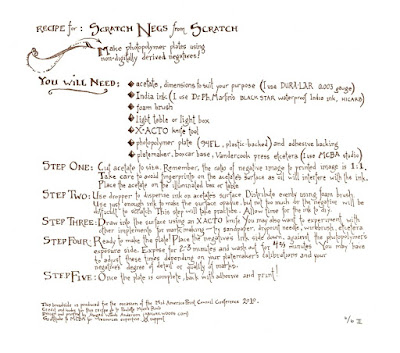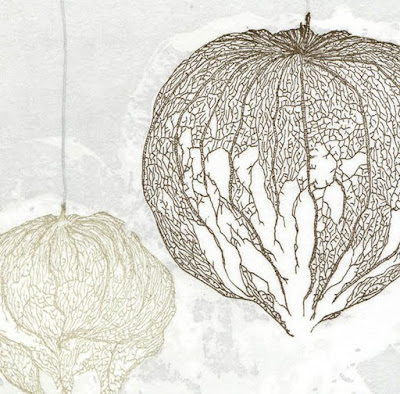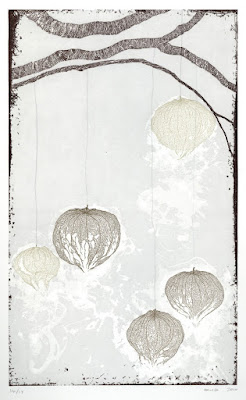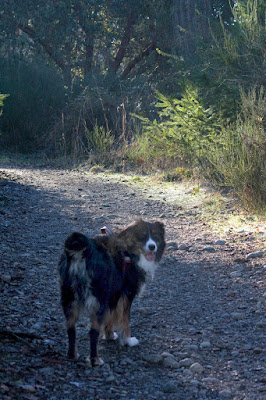If you are just starting out, a student or don't have the room for a nice press, printing intaglio work can be quite a challenge. I wanted to share a technique of pressless printing that I learned a long time ago from my friend, Margaret Craig, who teaches at the Southwest School or Arts in TX.
What you need are the normal things you would to print your plate + weights, transparent etching ink base and Golden Medium's Targel clear acrylic medium.
Here are some images of my quick setup at home. (You'll see I use some phonebook pages during plate wiping as well.)
In the picture above you can see the inks, targel (which you can get in smaller amounts), plates and plexi that I use to mix ink on. I chose a copper and zink plate from my old stash, the other has a deep aquatint on it and the other just a thin line etching. So you can use this technique for a wide variety of plates.
The picture below you can see my paper, cheap paintbrush, registration sheets and book that I used as weights.
Tip- learned from Dan Welden's newsletter that instead of tarlatan, you can also use organze silk for wiping your etching plates. If you can get your hands on some, give it a whirl... Supposedly it lasts longer than tarlatan.

Back to printing- Let the plate dry for an hour or more, depending if you are in a humid or dry environment. We have really dry indoor air in Germany so dry time was a couple of hours. This is a good time to get a snack, do some exercises, watch an episode of your favorite tv show or go play with your baby/dog or husband.




After the acrylic has dried, you can peel the paper off the plate and the ink will stick to the paper. If you peel too soon, as I do in the video, the targel is still wet and will not completely adhere to the paper. When the acrylic is dry, the plate will peel off quite easily- be mindul of peeling your edges though. If you got targel around the edges, it might not start peeling and will tear instead.
The reason that the technique works is that the acrylic dries much faster than the etching ink. We are using Targel because it has "an extremely resinous, syrupy, stringy and tar-like consistency" as described on the Golden website. It's so sticky that it pulls the ink from the grooves of your etching plate when you separate the paper from the plate.
Now, this technique obviously is not the fastest in the world, it will take you anywhere from an hour or more to pull an image, but compared to no press at all, it is better than nothing. If you commit to print an edition this way, I would advise to store your ink under ceramwrap on a glass or plexi. You could also fold the mixed ink in foil/waxpaper and keep it in the fridge. I have not tried it, but you could maybe try to speed up the process by blowdrying the paper on the back to dry the acrylic faster.
Here are images of the cow print. You can see the edges have some paintbrush marks, where I did not paint the targel on very evenly, and the middle has a spot where the targel did not adhere to the paper. That could have been either because I peeled the paper off before the gel had dried or because there was no clear etching base on that spot and the gel adhered to the plate instead of the paper. Maybe even heavier weights would have solved the problem. Best thing is to do a couple of practice prints- carefully coating the plate and to figure out how long you need to dry the print before peeling the paper off the plate.
Here is a closeup of the same print. I printed the cow two times, so this is a different print compared to the one that you see in the video.
For another variation for the adventurous printers out there, you can also print on just the targel without paper. Do all the steps just as above, but paint a slightly thicker coat of targel on top. Leave the paper and weights off the plate and just let it airdry. When the targel is dry, you can peel the skin off the plate, with your printing ink attached to it. Now you have a transparent, stretchy print, that you can let dry like that, you can stretch it over things or distort it in other ways. Margaret has done so in some of her works, you can see an example here.
Troubleshooting.
If you get spots in your print after you peel it off, try adjusting these things:
Your targel had not dried yet. Clean off any targel remains from your plate and start again and let your plate dry longer. Your paper and plate should separate fairly easily when you peel them apart -always be careful around the edges.
You did not cover your plate evenly with the clear etching ink and the acrylic got stuck to your plate instead of the paper. Clean plate, ink your plate again and be careful to cover the whole plate evenly.
You did not cover cover the plate evenly with targel, and some of the ink remains on your plate. Clean plate, ink your plate again and be careful to cover the whole plate with an even coat of gel. Be careful not to gob it on too thick either.
There was an air bubble in between your paper and plate. Smooth paper on the plate starting from one edge.
I hope this posting has been interesting for you. If you get a chance to try it, I'd be happy to post some pictures or experiences from others as well. Or if you have a problem that needs solving, let me know. Next post, we'll look at my latest small engraving. :)





























